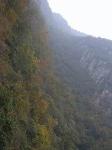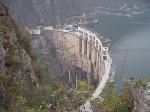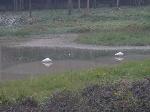- Getting around Lijiang. Dont stay in the Old Towns more than 2 days, there is nothing to do. KRISS Oct 9, 2013 05:46
- 2013 Beijing Temple Fair BENNYLAU Feb 26, 2013 03:29
- Malaysian traveling from KUL - LAX vis Shanghai PVG ZATI_DY Jan 3, 2013 20:15
Road trip to Hanzhong / Revenge of the birds
- Views: 5702
- |Vote: 1 0
- |Add to Favorites
- |Recommend to Friends
Introduction: A new expressway
The city of Hanzhong (汉中) lies in the southwest of Shaanxi province and is surrounded by the extensive Qingling and Daba mountain ranges. Due to this position Hanzhong has never been very easy to reach. Even though the distance to both Xi'an and Chengdu is relatively small, the city could only be reached by long and slow, winding train lines or regional roads. But just one month ago this all changed with the completion of one of the final pieces of the great Beijing-Kunming expressway; the Xi'an-Hanzhong section. Now Hanzhong is no more than a three and a halve hour bus ride away from Xi'an and Sichuan's capital of Chengdu has also become a lot 'closer' to Hanzhong with the travel time cut down to only 6 hours.
From the city of Xi'an a road trip to Hanzhong starts from the new bus terminal at the West Regional Bus Station (城西客运站) located at Zaoyuan East Road(枣园东路)From this unusually clean and convenient bus terminal, busses to Hanzhong leave every 20 minutes, all day long. A ticket is about 73RMB.
My companions and I were really astounded by the spotlessness and efficiency of this new bus station. I would even go as far as to say that it was better than the average airport; and especially when you compare it with your typical Chinese bus or train station, this new terminal is really where the 'great leap forward' is becoming visible. Similar words of praise can be used to describe the busses of the recently established Xi'an-Hanzhong Expressway Bus Company: new, clean, luxurious and altogether better then most of the airplanes I have ever traveled in. There even is a bus hostess providing the passengers with drinks and magazines! And if all that comfort isn't enough to make your trip fly by, the spectacular mountain views along the new expressway certainly will. Three and halve hours thus reduced to a mere flash.
Hanzhong
Hanzhong is most famous because of its strategic location during the period of the Three Kingdoms and as the place where Han Dynasty had its origin. Most of the places of interest in the city are therefore related to these two historical facts, with the most famous one being the Ancient Plank Road that in the old times connected Sichuan and Shaanxi province. I however chose not to visit these places, but selected some lesser known spots instead.
We arrived in the city at an -again- new and nice bus terminal located a little bit outside of Hanzhong's downtown area. Hanzhong is a fairly sized provincial city through which the Han river (汉河) quietly flows (a walk along its banks is said to be a very popular nighttime activity for many of the local people) Recent years have brought more and more prosperity to the city, which results in a visually rapidly developing central area. New department stores, malls and hotels are mushrooming everywhere and one of the main shopping streets recently got transformed into a European-style pedestrian area.
No description of a Chinese city without talking about the local food, so here goes: The most famous dish is -noticeably- the Hanzhong Mianpi (汉中面皮); you can find it everywhere in the city. It is a kind of cold, sliced noodle which is seasoned and served with some seasonal veggies such as cucumber or bean sprouts. I personally was thrilled to discover the local dishes made with Suan Cai (酸菜), sour vegetables that taste exactly the same as sauerkraut and are used in different dishes such as soup, porridge and vegetable-tofu (菜豆腐)
My first stop in the city was a visit to the Bao River Dam (褒河大坝) and the Shimen scenic zone, (石门风景区) which are located at the city's edge and can be reached by taking bus line 21 from the city center. First take the bus to the line's final stop and then you'll need to walk for about 10 more minutes along the high bank of the Bao River before you reach the entrance of the area. A ticket is 30RMB and for that price you can visit the Dam and the whole scenic area surrounding it.
Shimen might not be a very famous sight; I found it quite impressive. The dam is huge and situated in a very steep gorge [see picture]. Unlike the famous Three Gorges Dam, you can look and walk everywhere and it's even possible to make a (speed) boat tour over the estuary lake. Along the banks of this same lake the Shimen scenic walking trail was constructed which consist of some small shrines and pavilions linked together by a pathway that is hanging from the mountain sides. I found the quietness of the whole setting pretty relaxing and the autumn colors of the mountain vegetation were really brilliant.
The tomb of a great inventor
The Chinese often talk about the Four Great Inventions in Chinese history, which are the compass, gunpowder, printing and papermaking. The inventor of this last invention; a modern and standardized papermaking process is buried in a tomb near Hanzhong, in the county town of Yangxian (洋县) You can reach the place by first taking the regional bus to Yangxian town and then transferring to the local bus towards the Tomb (蔡伦墓/Cai Lun Mu)
To fully appreciate the tomb and the adjoining temple and small museum, some background information about the history of paper and its inventor Cai Lun(蔡伦)is essential:
Of course writing is as old as the human race itself, yet the invention of paper can be dated back to year of 105 AD. Before that time different materials were used to write on, with stone tablets being the most common things used around the world. In China itself also bamboo and pieces of silk were in use, but these materials were either too heavy or too expensive to make widespread utilization possible. Enter Cai Lun. This man working at the emperor's court during the time of the Eastern Han Dynasty thought of a new way of producing paper by using mainly tree bark and pieces of cloth as raw materials and then creating thin pieces of paper by suspending the fiber sheets into water and next draining them and then letting the sheets dry. This basic technique is still used in paper making up until today.
Cai Lun died in 121 AD, but his invention went on to make a rapid development of the Chinese civilization possible (trough widespread literature and literacy) in the next centuries. It wasn't until the 8th century that the Arabs copied the papermaking technique and brought it to the Middle East, from which it spread to Europe in the 12th century, and later all over the world.
Taking the abovementioned story into account and considering the huge impact of paper on the development of the world, the Tomb of Cai Lun (sometimes named as one of the most influential people in history) is rather modest.
For 25RMB you can enter the tomb complex which is basically a small temple compound, containing some exhibitions about the history of paper, a small shrine and finally the pyramid-shaped grave hill of Cai Lun himself. More interesting is the small demonstration area to the immediate left of the temples where they are still making paper the exact way Cai Lun started it. It is interesting to see all the different steps in the process and I was quite surprised by how ingenious this ancient papermaking procedure actually is.
The Cai Lun Tomb and Papermaking museum is altogether a small sight. You can spend there 2 hours at most. It is certainly interesting, but I think a lot of detouring just in order to visit this place is not really worthwhile, unless you combine it with Yangxian County's other attraction: the Crested Ibis Reserve.
Revenge of the birds
Just outside of Yangxian town lies a small conservation station that is dedicated to preventing the Crested Ibis from becoming extinct. This Ibis is a large, white bird with a red-skinned head and white plumes on its nape. The Yangxian Crested Ibis Reserve (洋县朱鹭然区) is a national reserve established in the early eighties to protect this rare bird that was thought be extinct trough the 1960s and 1970s. But then, in 1981, seven Ibises were found in Shaanxi province and after that the government immediately took action by setting up this reserve and small care and breeding center.
Before I tell you about how the birds take revenge on innocent foreign travelers, I'd first like to mention that the efforts of the conservation center have certainly paid off. Due to an effective protection and breeding program, the population of wild Ibises is now back from 7 to a few hundred and at the center, every year more then 100 new birds are born in captivity. Yet, this still remains one of the rarest species of birds on the planet and a visit to the center thus offers a unique chance to see this magnificent animal of which once only 7 were left on the entire planet.
Upon entering the center, a sign clearly says that entrance tickets are 20RMB. And so they are indeed....for Chinese people. When the ticket lady saw my foreign face, the price was at once raised to a staggering 320RMB. The reason for it was very simple according to the lady: the Chinese people had now been protecting the Ibis for over 26 years while the rest of the world didn't do a damn thing for the bird. And if we lazy Ibis deserters now want to see this bird, we need to pay for our two and a halve decades of ignorance!
I don't know about other foreigners visiting this place before, but I thought this reasoning was utterly ridiculous and nothing more then another way to get some extra bucks from naïve tourists and I wasn't planning on giving them that pleasure. Later they 'made an exception' and suggested a 120RMB admission fee, but then I suddenly remembered I had my passport with me and I happen to have a Chinese residence permit. This then makes me a Chinese resident and following their line of reasoning, they then couldn't blame me for not protecting the Ibis anymore. So in the end I also got in for 20 RMB but only because I could show them my residence permit. Obviously, almost none of the foreign tourists in China have a permit like that, and when they come to the center they actually hardly have any choice but to just pay the gigantic extra fee (mind you; the Reserve is located at the edge of a small county town about 60 kilometers from Hanzhong City so turning back is not a real option) And I wonder; What would you –the reader of this review- do? Just pay it? Or perhaps you even think their rationale for the additional fee is not that crazy after all? I'd like to know.
Final thought
Traveling, in my eyes, is one of the most wonderful things you can do in life. Every time that I feel kind of gloomy (which luckily is hardly ever) or insecure about what the future will bring me, I only have to remember all the spectacular places I have seen, the wonderful people I have met and all the fun things I have done, in order to make me feel better at once. Obviously traveling sometimes will lead to some bad experiences or unpleasant encounters too. Just look at the story titled "The whisper-tree guide book to Inner Mongoli" by Stocktov or Jabarootoo's "Tragedy of Travel" to read some examples. And even a comparatively small thing like being cheated with money can still cast a shadow over your afternoon or day's trip. Yet these things never outweigh all the joys of visiting new places. Therefore don't be fooled by the last paragraph of this travel review; a visit to Hanzhong certainly is a pleasurable experience!







 Copyright © 1998-2025 All rights reserved.
Copyright © 1998-2025 All rights reserved.
1.
Apr 19, 2015 21:39 Reply
Mr.WANG from china said:
well-written piece, and quite informative. "Revenge of the Birds" is a great play on revenge of the nerds, haha